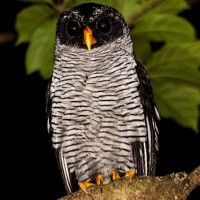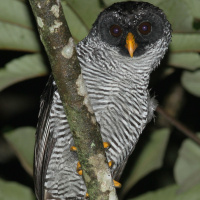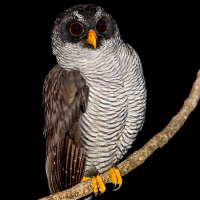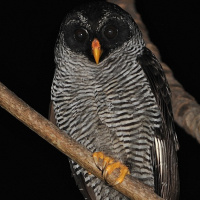Introduction
The Black-and-white Owl is a medium-sized owl with a rounded head and no ear-tufts. Its body is whitish below with dense blackish barring.
Photo Gallery (4 pictures)
Sound Gallery
Information
Description: The facial disc is blackish, with the rim and eyebrows densely speckled whitish and black. Eyes are dark reddish-brown to
blackish-brown. The cere is yellowish and the bill is pale orange-yellow. The rest of the head, crown and nape are sooty blackish-brown. There is a prominent
collar around the hindneck which is barred dusky and whitish. The rest of the upperparts are generally uniform dark sooty blackish-brown. The primary feathers
have whitish bars and a white terminal band.
The throat has a blackish bib, with the rest of the underparts are whitish with dense blackish barring. Tarsi are feathered and barred dusky and whitish.
Toes are bare and coloured dirty yellow to orange-yellow. Claws are yellowish-horn.
Size: Length 35-40cm. Wing length 255-293mm. Tail length 154-180mm. Weight 404-535g. Females are heavier than males.
Habits: The Black-and-white Owl is nocturnal, roosting during the day in dense foliage, among creepers or on a branch close to a tree trunk - normally well above the ground. Paired owls may be found roosting together.
Voice: The main call of the male is a series of rapid, low, guttural notes, gradually increasing in volume and pitch, followed by a loud, explosive and higher-pitched wow with a wailing quality, then a faint, short ho slightly lower in pitch. Together, the phrase is like this - wobobobobobo wow ho, and is repeated at intervals of several seconds. The female has a similar higher pitched song. A protracted, high-pitched who-ah is also described.
Hunting & Food: The Black-and-white Owl feeds primarily on insects, especially beetles, grasshoppers, locusts and crickets. They also take small mammals (including bats) and other small vertebrates such as birds and frogs. Prey are normally caught from a perch, but sometimes hawked in the air or taken on the wing from branches or leaves. Hunting of often done along forest edges. These owls are sometimes attracted to bright lights with swarming insects.
Breeding: Breeding biology is not well known. Breeds during the dry season (March-May in Central America). Usually nests in a natural hole in a rotten stump or tree trunk. May also use a thick branch between two epiphytes (a plant that grows upon another plant) or abandoned stick nests of larger birds. Normally two white eggs (average 46.4 x 38.4mm, 33.8g) are laid and incubated by the female alone, while the male provides food.
Habitat: Rainforest with clearings, forest edges, and semi-open swampy or flooded woodland. Also gallery forest and mangrove thickets. Ranges from sea-level up to about 1200m in Mexico, 2100m in Panama, and 2400m in Colombia. Can sometimes be found near human settlements.
Distribution: From central Mexico through Central America to northwest Colombia, northwest Venezuela and west Ecuador. May also be present in extreme northwest Peru.

Range of the Black-and-White Owl Strix nigrolineata
Status: Fairly Common. Listed as 'Least Concern' by Birdlife International.
Original Description: Sclater, Philip Lutley. 1859. Proceedings of the Zoological Society of London (PZS) Pt. (27) 2: p. 131.






